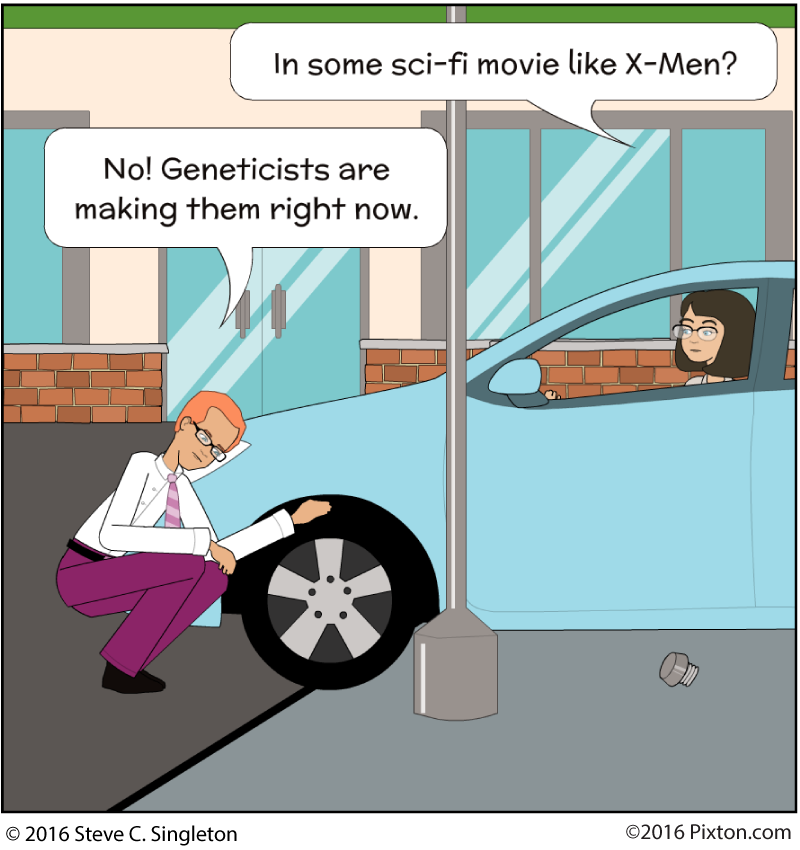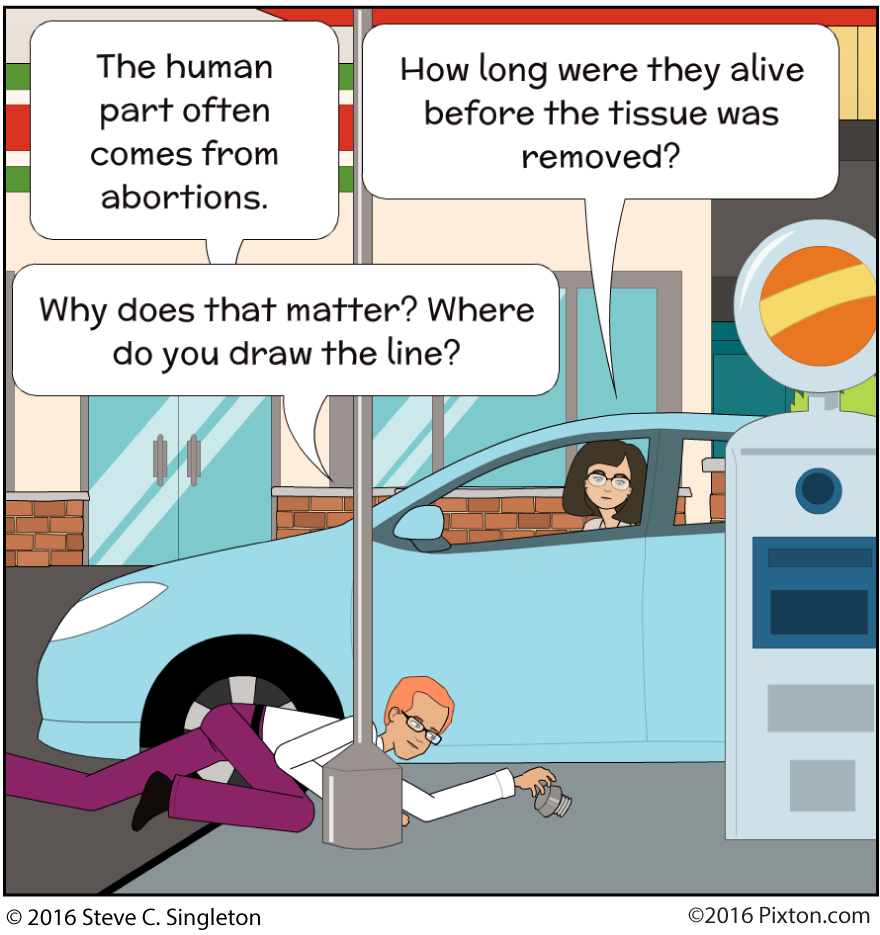On the creation of human/animal chimeras: Where do we draw the line?
What are chimeras and why are geneticists creating them?
On August 4, 2016, Rob Stein on National Public Radio reported that the National Institute of Health (NIH) has proposed changes in its guidelines for stem cell research and also proposed the creation of a steering committee to supervise funding for human-animal chimeras. The term ‘chimera’ comes from the hybrid creature of ancient Greek mythology that consisted of a lion with an additional head of the goat and detail ending in a snake’s head. Geneticists are creating chimeras by introducing human tissue into animals for the purpose of eventually generating tissues or organs that can later be transplanted into the bodies of humans that need them.
Until now, the NIH has maintained a moratorium on funding for all research projects involving the creation of human-animal chimeras. From now through September 6, the NIH is inviting public comments on its proposed changes.
Three issues to consider
Since I write as a concerned layperson, not as a geneticist, or even a biologist, I will limit my comments to where we should draw the line three issues: 1) how much of a chimera is human; 2) how early in the human’s embryonic development is its destruction justified; and 3) how long it will be before such chimeras developed human-like consciousness. This issue also raises a more general questions regarding how we should make our ethical decisions. I will address this near the close of this posting.
1. Where do we draw the line concerning how much of a chimera is human?
Researchers seek to allay fears that chimeras created in the laboratory are human half-breeds by pointing out that the human content is in the range of 1 – 3%, not 40 – 50%. This prompts the question: what is the greatest percentage of human content that is acceptable, though one additional percentage point more is unacceptable? The answer seems obvious: no such definite point exists. Either the camera has a human component or it does not; the ratio of human to nonhuman is irrelevant.
2. Where do we draw the line concerning the use of living human embryos?
A similar argument would apply to those who would justify the destruction of human embryos or zygotes on the basis of how early in the gestation process that destruction takes place. Where is the point along the continuum between conception and live birth that all can agree is the latest time that ending its life is justifiable? No one can agree where that point is.
3. Where do we draw the line concerning human-like consciousness in the chimera?
Nor can anyone determine how long it will take before chimeras develop the self-awareness characteristic of human beings. Most of us would agree that experimentation on animals with that quality or all of those near to such a psychological state would be morally wrong. Researchers reassure us that today’s chimeras are nowhere near that stage. Yet we cannot possibly hope to reach agreement when that stage will arrive and where short of that point researchers should call a halt.
As much as possible, ethics should be binary, not choosing a point along a continuum
The tendency to address ethical issues in terms of some rather arbitrary place along the infinite number of points on a continuum seems to be based on our multicultural society’s ethical relativism. According to ethics professor Scott B. Rae (86-87), “[Ethical relativism] holds that all values are culturally created, and, therefore, are not objective, universal moral principles applicable to all cultures and time periods. In other words, the culture determines the values…. Consequently, [according to ethical relativism] there are no objective, universal moral principles that are binding for all cultures and time periods.”
A secular society bases its ethics on the consensus of its citizens. Things become right or wrong according to the results of an election, a court ruling, or even a media bandwagon campaign. As long ago as 1979, Francis Schaeffer (A Christian Manifesto, reprinted in Complete Works, 5:439-441) recognized what was happening and wrote:
The materialistic-energy, chance concept of final reality never would have produced the form and freedom from government we have in this country and another reformation countries. But now it has arbitrarily and arrogantly supplanted the historic Judeo-Christian consensus that provided the basis for form and freedom in government. The Judeo-Christian consensus gave greater freedoms than the world has ever known, but it also contained the freedoms so that they did not pound society to pieces. The materialistic concept of reality would not have produced the form-freedom balance, and now that it has taken over it cannot maintain that balance. It has destroyed it….
Along with the decline of the Judeo-Christian consensus we have come to a new definition and connotation of “pluralism”…. [ Pluralism] now is used to mean that all types of situations are spread out before us, and that it really is up to each individual to grab one or the other on the way past, according to the whim of personal preference. What you take is only a matter of personal choice, with one choice as valid as another. Pluralism has come to mean that everything is acceptable. This new concept of pluralism suddenly is everywhere. There is no right or wrong; it is just a matter of your personal preference…. This new definition and connotation of pluralism is presented in many forms, not only in personal ethics, but in society’s ethics and in the choices concerning law….
From the material-energy, chance concept of final reality, final reality is, and must be by its nature, silent as to values, principles, or any basis for law. There is no way to ascertain “the ought” from “the is.” Not only should we have known what this would have produced, but on the basis of this viewpoint of reality, we should have recognized that there are no other conclusions that this view could produce. It is a natural result of really believing that the basic reality of all things is merely material-energy, shaped into its present form by impersonal chance.
As Christians committed to the God of Scripture, however, we believe that the standard of ethics our Lord demands of us is based, not on politics for public relations, but on the very character of the God we serve. “Be holy, because I, the Lord your God, am holy” (Leviticus 19:2). As such, His ethics transcends the limitations and relativism of human cultures. The statements of Scripture (such as Genesis 1:26-28; Genesis 2:7-25; Psalm 8:4-8; and Psalm 139:14) regarding the dignity of humanity point us in the direction of trying to safeguard our uniqueness.
Like being pregnant or not and like being either dead or alive, we should approach ethics as a series of binary choices: either we belong to the dominion of darkness or to the kingdom of God’s dear Son (Colossians 1:13); either we walk in the light or stumble in darkness (1 John 1:6-7; 2:9-11); either we are children of the kingdom or children of the evil one (Matthew 13:38, 43).
The only place we can draw the line where everyone agrees regarding human vs. animal portions is to exclude the human portion completely. The only certain line regarding the death of a human zygote or embryo is to prevent its destruction no matter how new it is. The only place to draw the line regarding self-awareness is at the beginning of the entire process. Thinking in terms of either-or simplifies and clarifies our ethical dilemmas, protects human life, safeguards human uniqueness, and avoids the quagmire of human-animal chimeras.
Genetic researchers have other avenues open to them that do not raise so many thorny ethical issues.
Want to go deeper?
- Francoise Baylis, et al. “Part-Human Chimeras: Worrying the Facts, Probing the Ethics.” The American Journal of Bioethics 7, 5 (2007): 41-58. First page. Accessed 8/12/2016.
- David Degrazia. “Human-animal Chimeras: Human Dignity, Moral Status, and Species Prejudice.” Metaphilosophy 38, 2-3 (April 2007): 309-329. Abstract. Accessed 8/12/2016.
- Insoo Hyun, Patrick Taylor, et al. “Ethical Standards for Human-to-Animal Camera Experiments in Stem Cell Research.” ISSCR: Committee Forum 1, 2 (16 August 2007): 159-163. Accessed 8/12/2016.
- Proposed changes to the NIH guidelines for stem cell research and the proposed NIH steering committee on the creation of human-animal chimeras: Call for public comments. Released August 4, 2016. Accessed 8/12/2016.
- Jason Scott Robert and Francoise Baylis. “Crossing Species Boundaries.” The American Journal of Bioethics 3, 3 (2003):1-13. Abstract. Accessed 8/12/2016.
- Rob Stein. “NIH Plans to Lift Ban on Research Finds for Part-Human, Part-Animal Embryos.” (aired on National Public Radio on 8/4/2016). Accessed 8/12/2016.
- Timeline of major events in stem cell research policy (from Research America: An Alliance for Discoveries in Health). Accessed 8/12/2016.
- Philip E. Hughes. Christian Ethics in Secular Society. Grand Rapids, Mich.: Baker, 1983. 123-147.
- Scott B. Rae. Moral Choices: An Introduction to Ethics. Grand Rapids, Mich.: Zondervan, 1995.
- Francis A. Schaeffer. Back to Freedom and Dignity (originally published in 1972). 1:357-373 in The Complete Works of Francis A. Schaeffer. Westchester, Ill.: Crossway, 1982.
- _________. “The Destruction of Faith and Freedom” in A Christian Manifesto (originally published in 1981). Westchester, Ill.: Cropssway, 1982.
- _________. “The Relativity of Morals” in Whatever Happened to the Human Race? (originally published in 1979). 5:367-370 in The Complete Works of Francis A. Schaeffer. Westchester, Ill.: Crossway, 1982.







